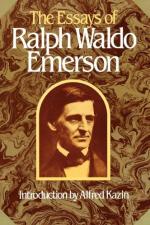[Footnote 364: Phocion. A Greek general and statesman of the fourth century before Christ who advised the Athenians to make peace with Philip of Macedon. He was put to death on a charge of treason.]
[Footnote 365: Lovejoy. Rev. Elijah Lovejoy, a Presbyterian clergyman of Maine who published a periodical against slavery. In 1837 an Illinois mob demanded his printing press, which he refused to give up. The building containing it was set on fire and when Lovejoy came out he was shot.]
[Footnote 366: Let them rave, etc. These lines are misquoted, being evidently given from memory, from Tennyson’s Dirge. In the poem occur these lines:
“Let
them rave.
Thou wilt never raise thine
head
From the green that folds
thy grave—
Let
them rave.”
]
MANNERS
[Footnote 367: The essay on Manners is from the Second Series of Essays, published in 1844, three years after the First Series. The essays in this volume, like those in the first, were, for the most part, made up of Emerson’s lectures, rearranged and corrected. The lecture on Manners had been delivered in the winter of 1841. He had given another lecture on the same subject about four years before, and several years later he treated of the same subject in his essay on Behavior in The Conduct of Life. You will find it interesting to read Behavior in connection with this essay.]
[Footnote 368: Feejee islanders. Since this essay was written, the people of the Feejee, or Fiji, Islands have become Christianized, and, to a large extent, civilized.]
[Footnote 369: Gournou. This description is found in A Narrative of the Operations and Recent Discoveries within the Pyramids, by Belzoni, an Italian traveler and explorer.]
[Footnote 370: Borgoo. A province of Africa.]
[Footnote 371: Tibboos, Bornoos. Tribes of Central Africa, mentioned in Heeren’s Historical Researches.]
[Footnote 372: Honors himself with architecture. Architecture was a subject in which Emerson was deeply interested. Read his poem, The Problem.]
[Footnote 373: Chivalry. Chivalry may be considered “as embodying the Middle Age conception of the ideal life of ... the Knights”; the word is often used to express “the ideal qualifications of a knight, as courtesy, generosity, valor, and dexterity in arms.” Fully to understand the order of Knighthood and the ideals of chivalry, you must read the history of Europe in the Middle Ages.]
[Footnote 374: Sir Philip Sidney. (See note 356.)]
[Footnote 375: Sir Walter Scott. (1771-1832). His historical novels dealing with the Middle Ages have some fine pictures of the chivalrous characters in which he delighted.]
[Footnote 376: Masonic sign. A sign of secret brotherhood, like the sign given by one Mason to another.]




